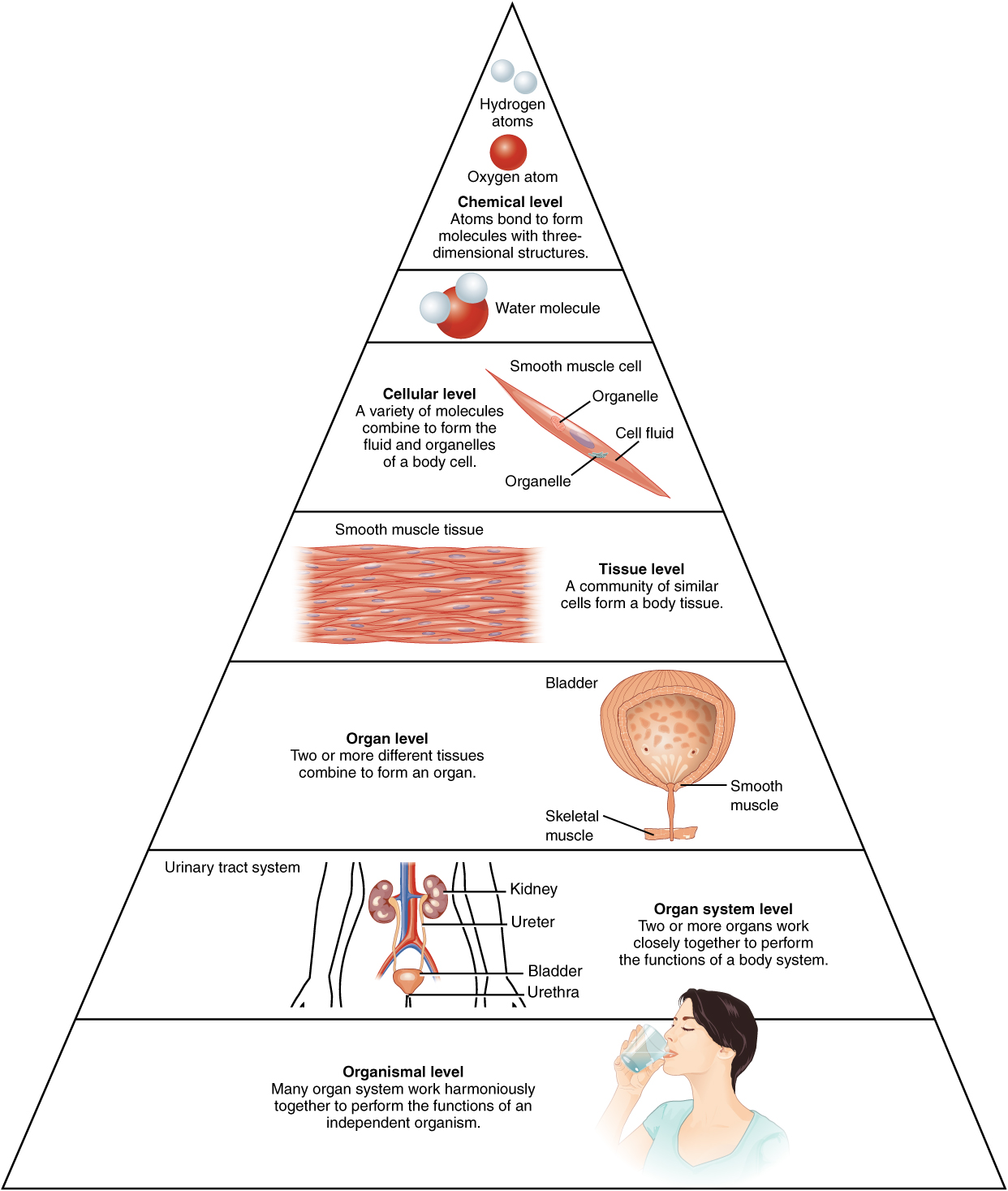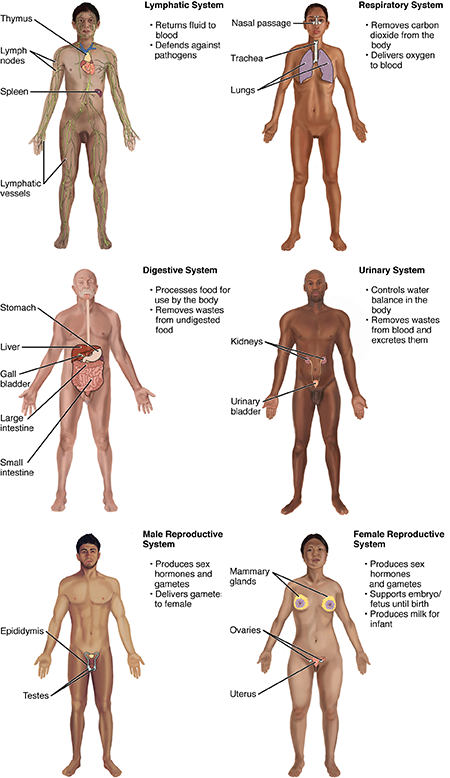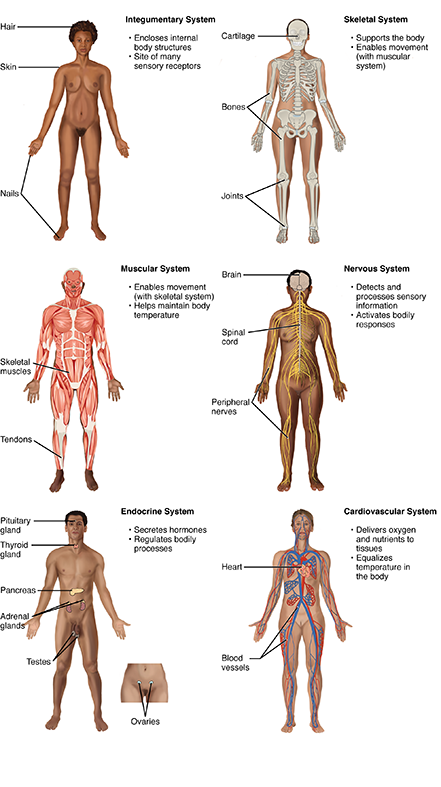Chapter 1. An Introduction to the Human Body
1.2 Structural Organization of the Human Body
Learning Objectives
By the end of this section, you will be able to:
- Describe the structure of the body, from simplest to most complex
- Describe the interrelationships between the organ systems
Before you begin to study the different structures and functions of the human body, it is helpful to consider its basic architecture—that is, how its smallest parts are assembled into larger structures. It is convenient to consider the structures of the body in terms of fundamental levels of organization that increase in complexity, such as (from smallest to largest) chemicals, cells, tissues, organs, organ systems, and an organism.

The organization of the body often is discussed in terms of the distinct levels of increasing complexity, from the smallest chemical building blocks to a unique human organism.
The Levels of Organization
To study the chemical level of organization, scientists consider the simplest building blocks of matter: subatomic particles, atoms and molecules. All matter in the universe is composed of one or more unique pure substances called elements. Examples of these elements are hydrogen, oxygen, carbon, nitrogen, calcium, and iron. The smallest unit of any of these pure substances (elements) is an atom. Atoms are made up of subatomic particles such as the proton, electron, and neutron. Two or more atoms combine to form a molecule, such as the water molecules, proteins, and sugars found in living things. Molecules are the chemical building blocks of all body structures.
A cell is the smallest independently functioning unit of a living organism. Single-celled organisms, like bacteria, are extremely small, independently living organisms with a cellular structure. Humans are multicellular organisms with independent cells working in concert together. Each bacterium is a single cell. All living structures of human anatomy contain cells, and almost all functions of human physiology are performed in cells or are initiated by cells.
A human cell typically consists of flexible membranes that enclose cytoplasm, a water-based cellular fluid, with a variety of tiny functioning units called organelles. In humans, as in all organisms, cells perform all functions of life.
A tissue is a group of many similar cells (though sometimes composed of a few related types) that work together to perform a specific function. An organ is an anatomically distinct structure of the body composed of two or more tissue types. Each organ performs one or more specific physiological functions. An organ system is a group of organs that work together to perform major functions or meet physiological needs of the body.
The human body is subdivided into eleven distinct organ systems (Figure 1.2.2). Assigning organs to organ systems can be imprecise because organs that “belong” to one system can also have functions integral to another system. In fact, most organs contribute to more than one system.

 Figure 1.2.2 – Organ Systems of the Human Body: Organs that work together are grouped into organ systems. [Image Description]
Figure 1.2.2 – Organ Systems of the Human Body: Organs that work together are grouped into organ systems. [Image Description]The organism level is the highest level of organization. An organism is a living being that has a cellular structure and can independently perform all physiologic functions necessary for life. In multicellular organisms, including humans, all cells, tissues, organs, and organ systems of the body work together to maintain the life and health of the organism.
Section Review
Life processes of the human body are maintained at several levels of structural organization. These include the chemical, cellular, tissue, organ, organ system, and organism level. Higher levels of organization are built from lower levels. Therefore, molecules combine to form cells, cells combine to form tissues, tissues combine to form organs, organs combine to form organ systems, and organ systems combine to form organisms.
Review Questions
Critical Thinking Questions
Glossary
- atom
- the smallest unit of an element that retains the properties of that element; made of subatomic particles
- cell
- the smallest independently functioning unit of a living organism
- chemical level
- the simplest level of organization in the human body, including atoms and molecules
- molecule
- a group of two or more atoms bonded together, forming substances such as proteins and sugars
- organ
- a body structure composed of at least two different tissue types that performs one or more specific functions
- organelle
- a tiny structure within a cell that performs a specific function necessary for the cell’s survival
- organism
- a living being with a cellular structure that can independently carry out all necessary life functions
- organism level
- the highest level of biological organization, where all systems work together to support life
- organ system
- a group of organs that work together to perform major body functions
- tissue
- a group of similar cells that work together to carry out a specific function
Glossary Flashcards
This work, Human Physiology, is adapted from Anatomy & Physiology by OpenStax, licensed under CC BY. This edition, with revised content and artwork, is licensed under CC BY-SA except where otherwise noted.
Images from Anatomy & Physiology by OpenStax are licensed under CC BY except where otherwise noted.
Access the original for free at OpenStax.
Image Descriptions
Figure 1.2.1. This illustration shows biological organization as a pyramid. The chemical level is at the apex of the pyramid where atoms bond to form molecules with three dimensional structures. An example is shown with two white hydrogen atoms bonding to a red oxygen atom to create water. The next level down on the pyramid is the cellular level, as illustrated with a long, tapered, smooth muscle cell. At this level, a variety of molecules combine to form the interior fluid and organelles of a body cell. The next level down is the tissue level. A community of similar cells forms body tissue. The example given here is a section of smooth muscle tissue, which contains many smooth muscle cells closely bound side by side. The next level down is the organ level, as illustrated with the bladder and urethra. The bladder contains smooth muscle while the urethra contains skeletal muscle. These are both examples of muscle tissues. The next level down is the organ system level, as illustrated by the entire urinary system containing the kidney, ureters, bladder and urethra. At this level, two or more organs work closely together to perform the functions of a body system. At the base of the pyramid is the organismal level illustrated with a woman drinking water. At this level, many organ systems work harmoniously together to perform the functions of an independent organism. [Return to Figure 1.2.1]
Figure 1.2.2. This illustration shows eight silhouettes of a human female, each showing the components of a different organ system. The integumentary system encloses internal body structures and is the site of many sensory receptors. The integumentary system includes the hair, skin, and nails. The skeletal system supports the body and, along with the muscular system, enables movement. The skeletal system includes cartilage, such as that at the tip of the nose, as well as the bones and joints. The muscular system enables movement, along with the skeletal system, but also helps to maintain body temperature. The muscular system includes skeletal muscles, as well as tendons that connect skeletal muscles to bones. The nervous system detects and processes sensory information and activates bodily responses. The nervous system includes the brain, spinal cord, and peripheral nerves, such as those located in the limbs. The endocrine system secretes hormones and regulates bodily processes. The endocrine system includes the pituitary gland in the brain, the thyroid gland in the throat, the pancreas in the abdomen, the adrenal glands on top of the kidneys, and the testes in the scrotum of males as well as the ovaries in the pelvic region of females. The cardiovascular system delivers oxygen and nutrients to the tissues as well as equalizes temperature in the body. The cardiovascular system includes the heart and blood vessels. [Return to Figure 1.2.2]
Report an Error
Did you find an error, typo, broken link, or other problem in the text? Please follow this link to the error reporting form to submit an error report to the authors.
